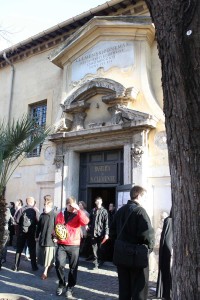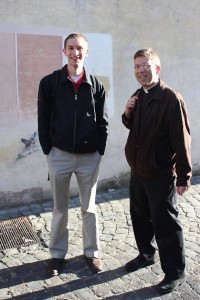A Church in Layers
One of the delights to be discovered about the city of Rome is its three-dimensionality: the city exists in layers. In a three-thousand-year-old city, it seems that every building is built on top of an older building. In the case of today’s station church, in fact, two older buildings. The current church of St. Clement, dedicated in 1128 and named after the fourth pope, rises on the ruins of its older 4th century predecessor. This, in turn, lies on top of a cluster of buildings from the imperial Roman era, one of which belonged to a wealthy Christian and had been entrusted to the Church for use as a parish. Few buildings better exemplify the continuity of our faith from its earliest days as a small and persecuted sect to its current status as a mature and flourishing religion.
Ecumenical Considerations
In addition to these archaeological delights, St. Clement holds another type of treasure: the relics of both St. Clement and of St. Ignatius of Antioch. The two men took opposite routes in their lives: St. Clement was exiled from Rome around 100 by the emperor and was later martyred near the Black Sea in the east, where he had gone to evangelize; St. Ignatius was arrested around the same time in Antioch (in Syria) and brought west to Rome to be thrown to the lions in the Coliseum. Today’s celebrant noted that in this church, “The Church breathes deeply with both lungs” – that is, with a faith handed on by both eastern Greek and western Latin Christians. We might pause today in our own Lenten journey to pray for the many other Christians who are also making this journey to Easter, our Orthodox and Protestant brethren, and to ask God that, through Christ, we might soon all be united in worship and belief as were Sts. Clement and Ignatius.
Pilgrim Profile
After Mass I stopped to chat with a tall and lanky college student who sang in today’s choir. Ephrem Shaffer is a seminarian from the diocese of St. Cloud, Minnesota, and a student at the University of St. Thomas in St. Paul, Minnesota. Ephrem arrived in Rome in January for a semester abroad, along with some 30 other students from St. Thomas. His dark and cold morning walk this morning to the 7 a.m. station church Mass took him about 50 minutes – “Done in a Lenten spirit of penance!” he laughs. But the lure of seeing ancient churches and approaching saints’ relics is tough to resist. “It is hard to think of faith as mythical after visiting these places. The saints are real people, and they have passed on to us an Incarnational faith.”



